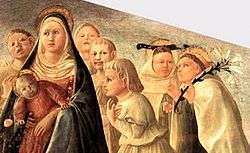Albert of Trapani
| Saint Albert of Trapani | |
|---|---|
|
Saint Albert (with lily) with the Virgin Mary and Saint Angelus (with knife), before 1431, by Filippo Lippi. | |
| Born | c. 1240 |
| Died | August 7, 1306 or 1307 |
| Venerated in | Catholic Church |
| Canonized | May 31, 1476, by Pope Sixtus IV |
| Feast | August 7 |
| Attributes | lily, book, the Devil; depicted alongside Saint Angelus |
| Patronage | Trapani; Carmelite Order; Carmelite schools |
Saint Albert of Trapani (Albert of Sicily, Albert degli Abbati) (c. 1240 – August 7, 1307),[1] was a Sicilian saint. Born in Trapani, he entered the Carmelite monastery there at a very young age and was later transferred to the Carmelite house at Messina.
He worked as a mendicant preacher to the Sicilians.
The lifting of a siege at Messina is attributed to him. In 1301, the city was under siege and blockaded by Duke Robert of Calabria. Responding to pleas for succor, Albert celebrated Mass. As he finished, three ships loaded with grain ran the blockade. Saved from starvation, the city was saved as Robert lifted the siege.
Veneration
His cultus was confirmed in 1454 and he was canonized on May 31, 1476, by Pope Sixtus IV.
The Whitefriar Street Carmelite Church in Dublin contains some of his relics. On his feast day (August 7), a relic of the saint is dipped into the water of St. Albert's Well and is said to grant healing of body and mind those who use the water.
Albert's skull is contained in a silver statue crafted in the 18th century by the engraver Vincenzo Bonaiuto, for the saint's altar in the basilica of Our Lady of Trapani.[2]
Albert is the patron saint of Trapani.
External links
Notes
|
